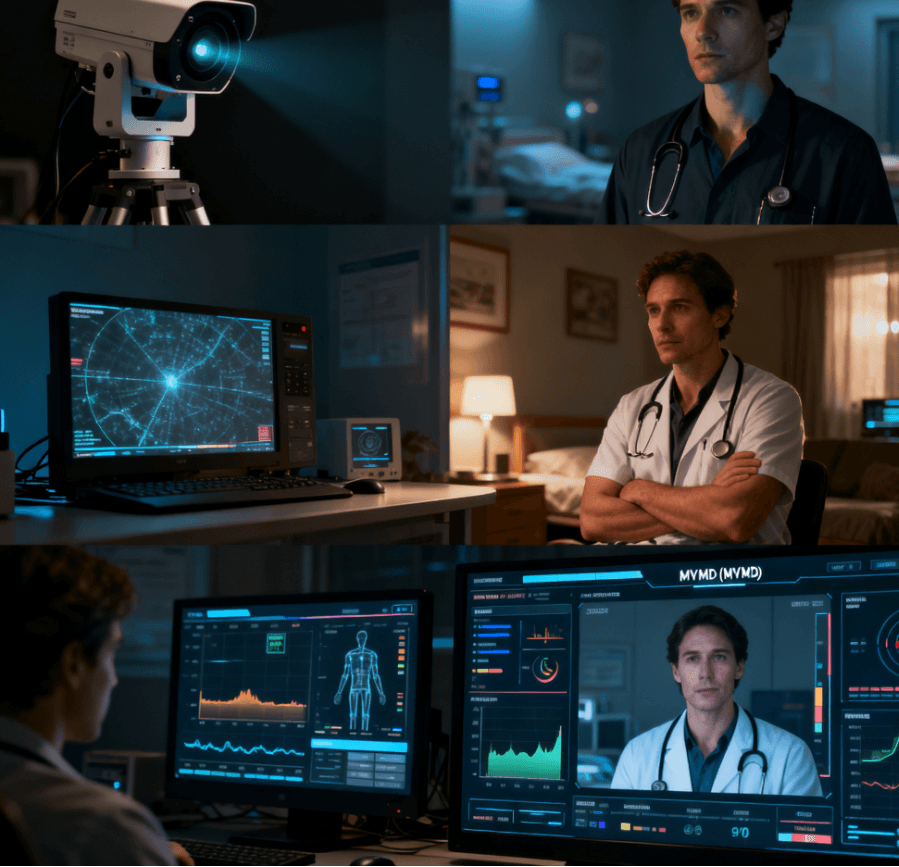Introduction: Advantages of Millimeter-Wave Radar for Contactless Monitoring
With the rapid growth of smart homes, healthcare, and in-vehicle safety applications, the demand for contactless physiological monitoring is increasing. Traditional contact-based sensors such as ECG electrodes, chest belts, or photoplethysmography (PPG) provide accurate measurements but can cause discomfort during prolonged use and limit deployment in bedrooms, hospitals, and public spaces.
Millimeter-wave (mmWave) radar offers an innovative solution. By transmitting electromagnetic waves in the 60–77 GHz band, mmWave radar can detect subtle chest movements caused by breathing and heartbeats, enabling contactless, round-the-clock, privacy-preserving monitoring. Unlike cameras, radar does not capture identifiable images, protecting user privacy. Compared to contact sensors, radar requires no wearable devices, providing a more natural user experience.
However, in real-world environments, a single radar may be affected by body posture, orientation, or obstruction. Sumi and Sakamoto (2025) proposed a multi-radar fusion approach combined with MVMD (Multivariate Variational Mode Decomposition), significantly enhancing the accuracy and stability of contactless respiration monitoring, offering a reliable solution for practical deployment.
Multi-Radar Fusion: Principles and Advantages
A single radar only captures chest displacement from a single viewpoint. When the subject turns away or changes posture, signal amplitude may decrease and noise increases, distorting the respiration waveform.
To address this, the research team deployed three mmWave radars, simultaneously capturing chest displacement signals from different angles. Signals were processed using MVMD, achieving effective information fusion and noise suppression.
MVMD Principle
MVMD is a multivariate extension of variational mode decomposition that processes multiple related signal channels while maintaining phase consistency. Its advantages include:
-
Joint decomposition: Common respiration patterns across channels are effectively extracted.
-
Noise suppression: Environmental noise and motion artifacts are removed, improving signal quality.
-
Mode fusion: Principal Component Analysis (PCA) integrates modes to generate stable respiration waveforms.
Workflow:
-
Each radar acquires chest displacement signals xi(t)x_i(t).
-
MVMD decomposes signals into intrinsic mode functions (IMFs).
-
Phase alignment is applied across modes.
-
PCA fuses aligned modes to produce a stable, reliable respiration signal.
By fusing multiple radar perspectives, the system effectively mitigates posture and orientation effects.
Experimental Design and Results
Experimental Setup
The system was validated in a controlled laboratory environment:
-
Radar configuration: Three 60 GHz FMCW radars spaced 120° around the subject.
-
Subjects: Six healthy adults tested in three orientations (front, side, back).
-
Measurement distances: 1.5 m and 3.0 m.
-
Multi-person scenario: 10 subjects monitored simultaneously to evaluate signal separation.
Reference respiration intervals were measured with contact-based sensors.
Results
The multi-radar + MVMD system achieved high performance in single-subject tests:
| Metric | Single Radar | Multi-Radar + MVMD | Improvement |
|---|---|---|---|
| Respiration Interval RMSE | – | ↓ 35.5% | ✔ |
| Respiration Rate MAE | – | ↓ 30.8% | ✔ |
| Respiration Accuracy | – | ↑ 9.4 percentage points | ✔ |
In multi-person scenarios, performance remained robust:
-
Respiration interval RMSE improved by 23.5%
-
Respiration rate MAE improved by 22.3%
-
Accuracy increased by 6.2 percentage points
These results demonstrate that multi-radar fusion with MVMD can reliably extract respiration information across different postures and in multi-person settings, significantly enhancing robustness and reliability.
Core Advantages of mmWave Radar
1. Contactless and Comfortable
No direct skin contact is required, providing a natural and comfortable user experience for home and healthcare scenarios.
2. Privacy-Preserving
Radar only captures motion data, not identifiable images, ensuring privacy in bedrooms, hospitals, and public spaces.
3. Penetrates Clothing and Bedding
Millimeter waves can penetrate thin clothing and blankets, ensuring reliable data collection in daily environments.
4. High Resolution and Real-Time Monitoring
mmWave radar provides high-resolution displacement signals, enabling continuous respiration tracking for sleep analysis, health management, and anomaly detection.
5. Multi-Scenario Applicability
Suitable for smart homes, healthcare, in-vehicle monitoring, and human-machine interaction. Multi-radar fusion ensures stable monitoring in complex environments.
6. Robustness through Multi-Radar Fusion
Combining signals from multiple angles with MVMD ensures reliable respiration waveform output, even when the subject changes posture or faces away from the radar.
Linpowave Application Value
Linpowave’s 60 GHz radar modules (e.g., R60A, R60ABD1) support multi-device synchronization and phase-consistent processing, perfectly suitable for MVMD multi-radar fusion applications.
Typical applications include:
-
Smart Homes: Sleep monitoring and health management.
-
Healthcare and Elderly Care: Contactless respiration monitoring for patients and elderly individuals.
-
In-Vehicle Monitoring: Driver and passenger status detection for enhanced safety.
-
Human-Machine Interaction: Intelligent robots sensing user states to provide adaptive responses.
More information:
FAQ (Frequently Asked Questions)
Q1: Can mmWave radar detect heart rate?
A1: Respiration signals are larger in amplitude, while heart rate signals are subtler. With multi-radar fusion and high-resolution sampling, future implementations could enable heart rate monitoring.
Q2: Is multi-radar setup complicated?
A2: Three radars spaced 120° can cover primary postures. Linpowave modules support multi-device synchronization, simplifying setup and data processing.
Q3: Will clothing or blankets affect radar signals?
A3: mmWave can penetrate thin clothing and blankets. Very thick blankets may slightly attenuate signals, but impact on respiration monitoring is minimal.
Q4: Can it monitor multiple people simultaneously?
A4: Yes, experiments show multi-radar fusion can distinguish respiration signals from multiple individuals, suitable for homes, wards, or public care environments.
Q5: Is radar monitoring safe?
A5: 60 GHz mmWave power is lower than mobile phones or Wi-Fi, classified as non-ionizing radiation, safe for long-term use.
Q6: Is deployment costly?
A6: With decreasing module costs, multi-radar systems are cost-effective and flexible, suitable for commercial and home applications.
Conclusion and Outlook
Multi-radar fusion with MVMD provides a highly accurate, stable, and user-friendly solution for contactless physiological monitoring.
By integrating multi-perspective data acquisition and intelligent signal processing, the system adapts to various postures, multi-person scenarios, and everyday environments, delivering continuous, interference-free, privacy-preserving respiration monitoring.
As mmWave radar technology continues to advance, this approach will play an increasingly significant role in smart homes, healthcare, and in-vehicle monitoring, enabling smarter, calmer, and more human-centric environmental sensing.



